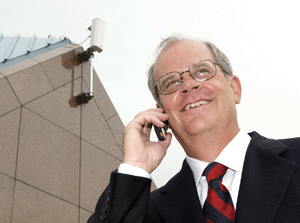Ringing through

State and local governments are beginning a major retooling of their telecom infrastructures, replacing legacy systems, boosting connect speeds and, with an array of state-of-the-art wireless devices, untethering deskbound civil servants.
State and local governments are beginning a major retooling of their telecom infrastructures, replacing legacy systems, boosting connect speeds and, with an array of state-of-the-art wireless devices, untethering deskbound civil servants.When complete, the upgrades are meant to let local governments rapidly respond to terrorist threats and improve e-government services to citizens.Vendors and system integrators that win contracts to design and install these systems will be key players in local governments' planned transformation.According to Jim Krouse, manager of market analysis for IT research firm Input Inc. of Reston, Va., governments' adoption of wireless and voice over IP technologies "will change the dynamics of the market in the next three years. Telecom markets [will move] into one of the most dynamic periods in their history ... Systems integrators are in an excellent position for significant work."Despite a continued drop in the IT consumer price index, which Krouse said has fallen an average 2 percent annually for 25 years, demand for telecom expertise and affiliated services will increase more quickly than equipment prices will fall. As the author of Input's July report, "Market Growth and Prospects in Government Telecommunications and Network Services," Krouse said the telecommunications and network services sector as a percentage of overall IT spending will grow from 19.8 percent in 2005 to 22.9 percent in 2010, a compound annual growth rate of 11.4 percent.By fiscal 2010, total telecom spending will balloon by roughly 70 percent, to $16.4 billion from $9.6 billion in fiscal 2005.One immediate goal of the telecom retooling will be to increase connectivity options for first responders and other government-affiliated emergency services. Wireless technologies inevitably will replace cable and LAN services, especially to provide Internet access to remote regions where, even today, access to wired telephony can be spotty, Krouse said. Although citizens living in remote areas stand to benefit the most from high-speed wireless connectivity, local governments also eventually will profit. Over time, government could reduce overhead and increase citizen access as municipal workers literally take their services on the road."Mobility is the next big advantage," said John Gillispie, Iowa's chief operating officer for IT and vice chair of the Interoperability and Integration Committee for the National Association of State Chief Information Officers. "Mobile workers will have an office in a box at a remote location. That's a pretty powerful solution."Pilot programs to test the feasibility of next-gen telecom are ongoing. Last November, San Diego-based Science Applications International Corp. won an experimental license from the Federal Communications Commission to do trials in several cities of wireless networks and devices in the 4.9-GHz frequency range, reserved for use by public safety organizations. The 4.9 band interests local governments because of its potential incorporation into proposed metropolitan area networks that would provide prioritized voice and VOIP, digital video; traffic control; and wireless access to emergency call boxes.Another major telecom player, Northrop Grumman Corp., in August 2004 won a two-phase contract from Santa Clara, Calif., for an integrated voice and data wireless system that will improve communications between public safety agencies in the county during major emergencies.The Silicon Valley Regional Interoperability Project will link 32 of the municipal and county government public safety agencies in Santa Clara County through a wireless, integrated voice and data system. Northrop Grumman is in the second phase of the project, which includes engineering, integration, systems verification and implementation."State and local markets are really heating up, and 9/11 is driving it," said Royce Kincaid, Northrop Grumman IT program manager for wireless networks. He said the terrorist incidents in London and Madrid have expedited network adoption. "You'll see a lot of money being spent in the next 10 years," he said.The improvements, many driven by the nationwide increase in telecom upgrades for homeland security, must ensure backward compatibility with legacy systems and interoperability among applications, Kincaid said.The many remaining IT stovepipes and custom or homegrown applications pose one of the biggest challenges for state and local governments. Cost also is an issue, with the richest communities likely to see the fastest progress and most immediate benefits. Without external funding, rural and poorer locales likely will be the last onboard."I'd guess that within another four to five years, the overall infrastructure for VoIP and wireless should be there," said Karen Jackson, vice president of broadband programs for Virginia's Center for Innovative Technology in Herndon, Va."A number of localities have to spread out the capital outlays. It's moving, but it's moving at different speeds depending on where you are and how much cash you have."Jim Schultz is a freelance writer in Norfolk, Va. E-mail him at jschultz76@cox.net.


"State and local markets are really heating up, and 9/11 is driving it." ? Royce Kincaid, Northrop Grumman
Henrik G. de Gyor

